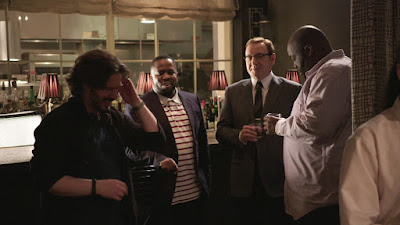Setting
 |
| From left to right: Director Edgar Wright, OutKast member Big Boi, Kevin Spacey, and Atlanta rapper Killer Mike |
Baby Driver was both filmed and set in Atlanta, Georgia. Atlanta's prolific cultures behind music and cars make it the perfect backdrop for Baby's musical getaways. To display Atlanta's rich culture, Wright included several of the city's culinary landmarks, such as Godfather's Pizza and Octane Coffee, as well as cameos from some of the areas most high profile artists, Killer Mike and Big Boi.
The ethos of Atlanta also helps contextualize the crime that takes place throughout the film. In an interview with Complex, Wright said “It’s a travel hub, so it makes sense that it would be the place where criminals would meet up and split again.”
Lighting
Baby Driver utilizes different styles of lighting in order to show contrast between Baby's personal life and his criminal career. Three point lighting is used in scenes where Baby is with his foster dad, Joseph, or his love interest, Deborah. This creates a warm, comforting feeling, which underscores Baby's feelings towards those characters.
 |
| Three point lighting in a scene where Baby talk's to his love interest, Deborah, in a diner. |
 |
| Low-key lighting in a meeting with Baby's robbery crew. |
In contrast, low-key lighting is used in scenes where Baby is dealing with his criminal squad. This parallels the idea that this is the darker, more murky part of Baby's life.
The lighting acts as a leit motif to signal to the audience what subject matter Baby will be dealing with in any given scene.
Costumes
 |
| From left to right: Baby (Ansel Elgort), Bats (Jamie Foxx), Darling (Eiza Gonzalez), and Buddy (Jon Hamm). |
In the film, costuming is used to parallel the different personalities of Baby's criminal partners. The most notable use of this technique can be seen with Jon Hamm's character, Buddy (pictured on the far right). Buddy's all black costume design is meant to symbolize what happens when a person's life becomes consumed by their criminality. In a scene later in the movie, we discover that his character used to be a successful businessman who turned to crime to pay for drugs under the table.
 |
| Baby in the film's climax, wearing a grey undershirt to symbolize his plunge into criminality. |
The motif of black symbolizing crime is utilized to show Baby's character arc of needing to get his hands dirty in order to break free of his past to be with Deborah. In the beginning of the movie, Baby can be seen wearing a white undershirt, symbolizing his innocence both emotionally and legally. As the plot advances, and Baby get further entrapped in his job, his undershirt becomes darker to demonstrate that he is moving closer towards being consumed by his criminality, like Buddy.
Staging and Acting
Ansel Elgort brings the character of Baby to life with his subdued, yet expressive performance. Elgort has very little dialogue in the movie, so we are left to analyze his emotions and thoughts through his movements and facial expressions. This can be now better displayed than in the second scene of the film, where Baby gets a reprieve from his shady job to go get coffee. Baby's relief is exemplified by his lighthearted dancing down the street as he listens to the Harlem Shuffle by Bob and Earl.



